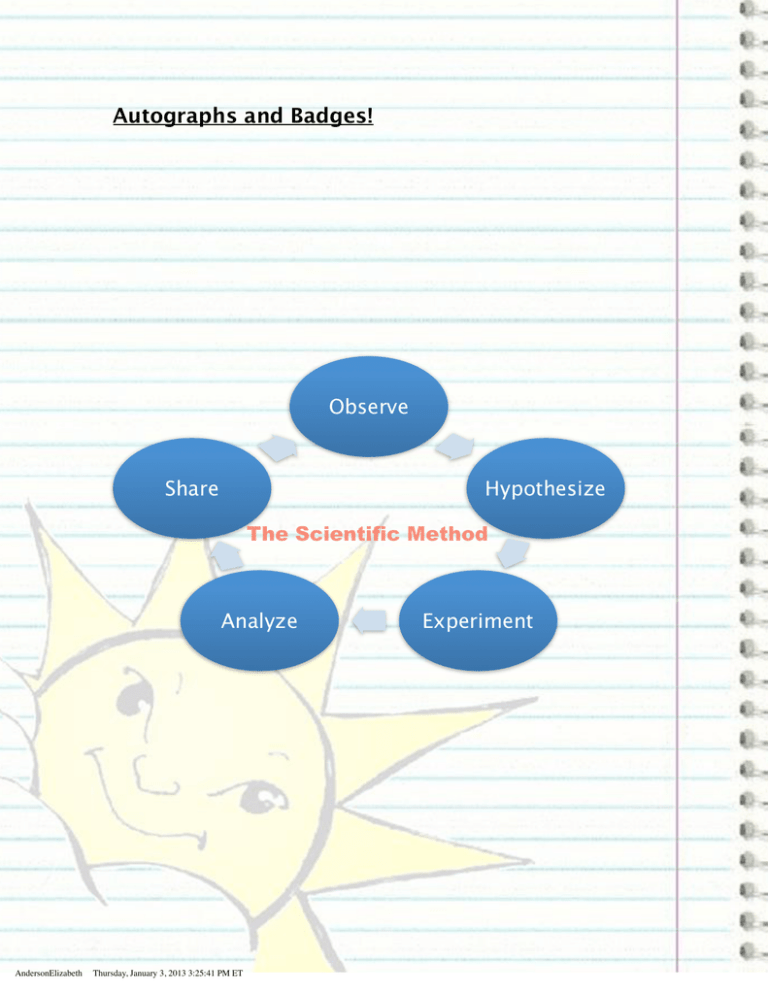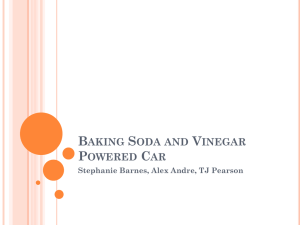Document 12939588
advertisement

Autographs and Badges! Observe Share Hypothesize The Scientific Method Analyze AndersonElizabeth Thursday, January 3, 2013 3:25:41 PM ET Experiment Laboratory Notebook Under Pressure My Name:_____________________________ Date:______________________________ Laboratory AndersonElizabeth Thursday, January 3, 2013 3:25:41 PM ET 2 Part 1: Under Pressure Lab (modified from Elementary Science with Vernier, Activity 18) Introduction: Do you ever wonder why you can only blow so much air into a balloon before it bursts? Or why a volcano erupts and shoots gases, dust, and molten rock high up into the air? This activity will allow you to explore reactions similar to these in the safety of your own classroom! Be sure to wear your safety goggles whenever you work with chemical reactions — this activity is a BLAST! Notes: What is air pressure? MATERIALS LabQuest Vernier Gas Pressure Sensor plastic tubing and stopper assembly 50 mL vinegar 3 spoonfuls baking soda cup with marking on side plastic spoon plastic bottle water goggles paper towels or rags to clean up spills tray AndersonElizabeth Thursday, January 3, 2013 3:25:41 PM ET Data Analysis: Draw a graph of your data. AndersonElizabeth Thursday, January 3, 2013 3:25:41 PM ET 7 6 Data Analysis: 1.! How did the pressure in the bottle change during the reaction? What do you think caused this change? 2.! Tap Run 3 on the Graph screen and choose All Runs to display all of your data on the same graph. Describe any pattern you noticed as you changed the amount of vinegar you added to the baking soda inside the bottle. AndersonElizabeth Thursday, January 3, 2013 3:25:41 PM ET 3 Research Question: What happens to the air pressure when you combine baking soda and vinegar in a plastic water bottle ? Hypothesis: As the volume of vinegar increases, the air pressure in the water bottle ____________________. Experimental Design: Independent Variable – Dependent Variable – Which variables will you need to keep constant? AndersonElizabeth Thursday, January 3, 2013 3:25:41 PM ET 4 Procedure: 1. Get a pair of goggles and put them on. Make sure each person in your group wears them during this activity. 2. Do the following to get the Pressure Sensor ready to collect data. a. Make sure the Pressure Sensor is connected to LabQuest. b. Close the valve on the stopper. The handle should be sideways to the valve. See the drawing at the right to show what the valve looks like when it is closed and open. Note: During this activity you will rotate the handle, opening and closing the system when you need to, so make sure you understand the drawings. 3. Choose New from the File menu. 4. On the Meter screen, tap Length. Change the data-collection length to 120 seconds. Select OK. 5. Place one leveled-off, plastic spoonful of baking soda in the plastic bottle. 6. Twist the stopper into the mouth of the bottle so it fits tightly. Important: The stopper must be twisted in tightly or it may pop out during the reaction. 7. Close the system by rotating the handle on the valve so it is sideways to the valve (like the “Valve Closed” drawing above). Remember, in this position, the system is closed and nothing can move in or out. 8. Now, get vinegar in the syringe by following the steps below: a. b. c. d. Get about 50 mL of vinegar in your cup. Pick up the syringe and push the plunger all the way into the syringe. Place the tip of the syringe into the vinegar in your cup. Draw 5 mL of vinegar up into the syringe by pulling up on the plunger until the front edge of the plunger is at the 5 mL mark. 9. Attach the syringe to the stopper by doing the following: a. Make sure the handle on the stopper is in the closed position. b. Gently twist the syringe onto the handle valve. Caution: Do not twist too far; it only takes about 1/2 turn. AndersonElizabeth Thursday, January 3, 2013 3:25:41 PM ET 5 10. You will now collect data. Important: This step needs to be done quickly, so read through the directions once before you do anything. When you have read and understood the directions, you can collect data. a. Twist the handle on the valve so that it is in the open position. b. Start data collection. c. Press and hold the plunger down to add the vinegar. d. Once all the vinegar is in the bottle, quickly twist the handle on the valve to close the system (making a plus sign). e. Gently swirl the bottle so all the vinegar reacts with the baking soda. Caution: Do not shake the bottle! 11. Fill out the Data Table below for this run by following the steps below: a. Tap the Table tab and find the pressure at the beginning of the run (the Pressure value at Time = 0 sec). b. Write down this value as the beginning pressure for this run. c. Now, scroll down through the data to find the final pressure (the pressure value at time = 40 seconds). d. Write down this value as the final pressure for this run. 12. Tap the Graph tab and then tap the File Cabinet icon to store this run. 13. Empty the bottle as instructed by your teacher, then rinse it with water. 14. Repeat Steps 5–13, but this time, use 10 mL of vinegar. 15. Repeat Steps 5–11, but this time, use 15 mL of vinegar. 16. Empty the bottle as instructed by your teacher, then rinse it with water. Data: AndersonElizabeth Run Amount of baking soda Volume of Vinegar 1 1 spoon 5 mL kPa kPa kPa 2 1 spoon 10 mL kPa kPa kPa 3 1 spoon 15 mL kPa kPa kPa Thursday, January 3, 2013 3:25:41 PM ET Beginning Pressure Final Pressure Change in Pressure




